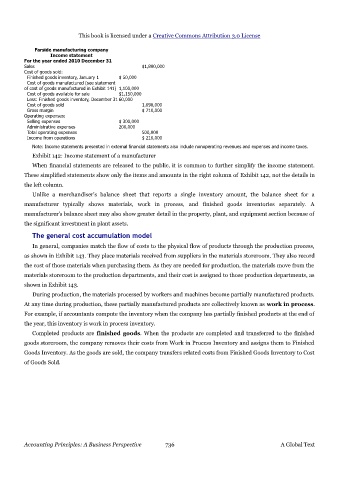Page 735 - Accounting Principles (A Business Perspective)
P. 735
This book is licensed under a Creative Commons Attribution 3.0 License
Farside manufacturing company
Income statement
For the year ended 2010 December 31
Sales $1,800,000
Cost of goods sold:
Finished goods inventory, January 1 $ 50,000
Cost of goods manufactured (see statement
of cost of goods manufactured in Exhibit 141) 1,100,000
Cost of goods available for sale $1,150,000
Less: Finished goods inventory, December 31 60,000
Cost of goods sold 1,090,000
Gross margin $ 710,000
Operating expenses:
Selling expenses $ 300,000
Administrative expenses 200,000
Total operating expenses 500,000
Income from operations $ 210,000
Note: Income statements presented in external financial statements also include nonoperating revenues and expenses and income taxes.
Exhibit 142: Income statement of a manufacturer
When financial statements are released to the public, it is common to further simplify the income statement.
These simplified statements show only the items and amounts in the right column of Exhibit 142, not the details in
the left column.
Unlike a merchandiser's balance sheet that reports a single inventory amount, the balance sheet for a
manufacturer typically shows materials, work in process, and finished goods inventories separately. A
manufacturer's balance sheet may also show greater detail in the property, plant, and equipment section because of
the significant investment in plant assets.
The general cost accumulation model
In general, companies match the flow of costs to the physical flow of products through the production process,
as shown in Exhibit 143. They place materials received from suppliers in the materials storeroom. They also record
the cost of those materials when purchasing them. As they are needed for production, the materials move from the
materials storeroom to the production departments, and their cost is assigned to those production departments, as
shown in Exhibit 143.
During production, the materials processed by workers and machines become partially manufactured products.
At any time during production, these partially manufactured products are collectively known as work in process.
For example, if accountants compute the inventory when the company has partially finished products at the end of
the year, this inventory is work in process inventory.
Completed products are finished goods. When the products are completed and transferred to the finished
goods storeroom, the company removes their costs from Work in Process Inventory and assigns them to Finished
Goods Inventory. As the goods are sold, the company transfers related costs from Finished Goods Inventory to Cost
of Goods Sold.
Accounting Principles: A Business Perspective 736 A Global Text

